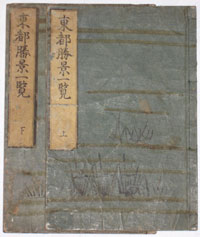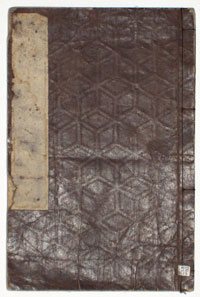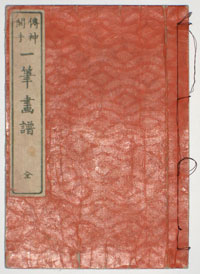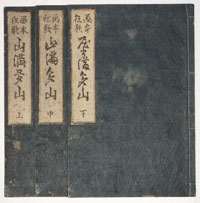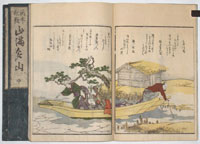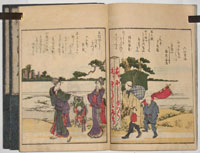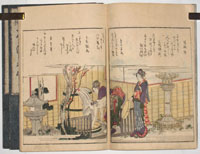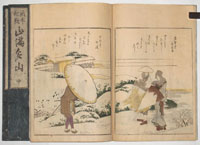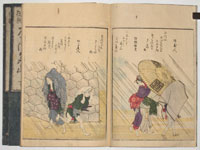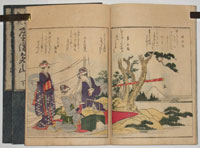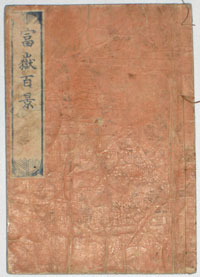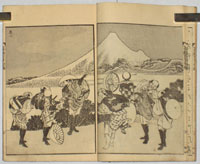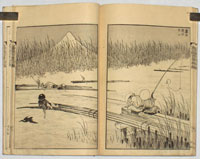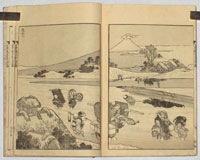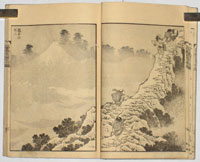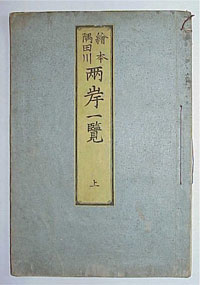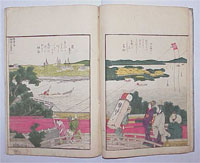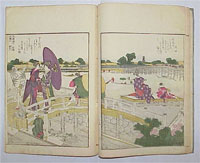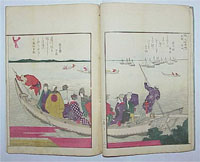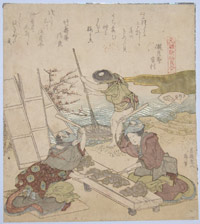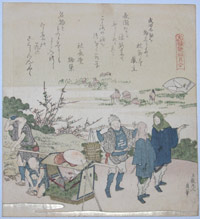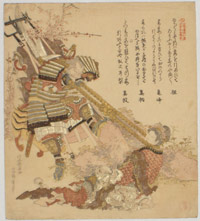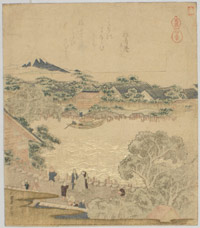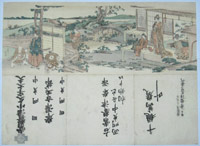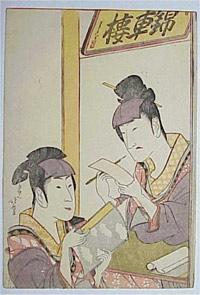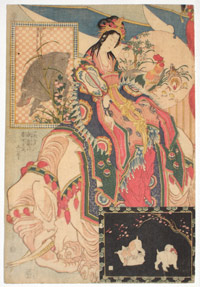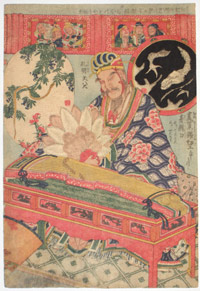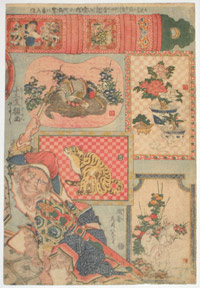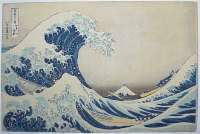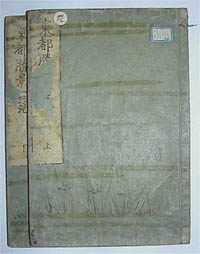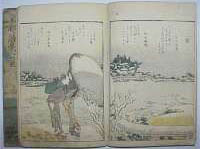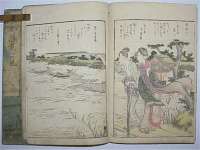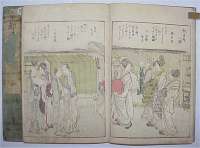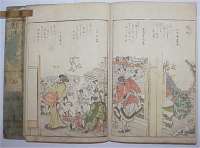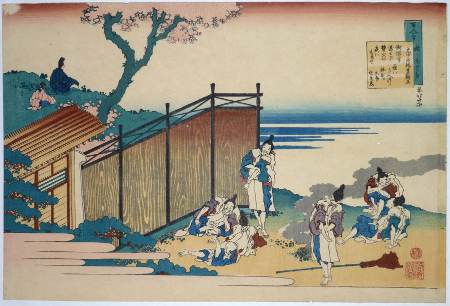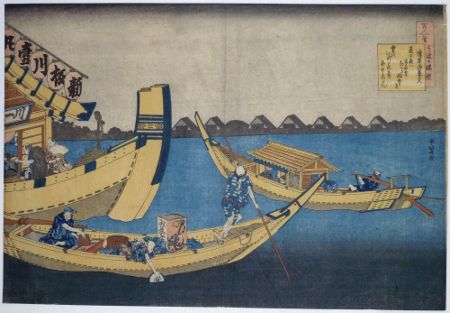Katsushika HOKUSAI (1760-1849)
Click here to view image full size.
Two volumes complete: Toto shokei ichiran ( alternative title: Toto meisho ichiran ), “Fine Views of the Eastern Capital at a Glance.” The first of three important works showing the sights of Edo in colour prints. ( See this website for examples of the other two. ) Published Kansai 12 ( 1800 ) by Suwaraya Mohei, Suwaraya Ihachi and Tsutaya Jusaburo, Edo.
Original hand-painted blue-green covers with original title slips. One or two minor marks, otherwise a nice example with perfect colour. In chitsu.
Status: Sold
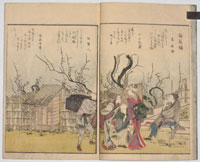
Click here to view image full size.
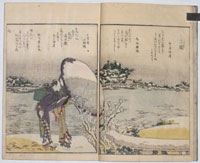
Click here to view image full size.
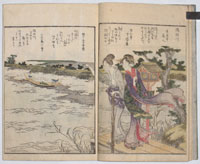
Click here to view image full size.
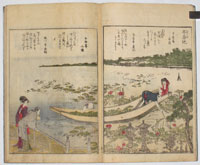
Click here to view image full size.
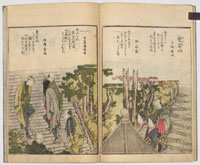
Click here to view image full size.
Katsushika HOKUSAI (1760-1849)
Click here to view image full size.
One volume complete: Shuga ichiran, “Excellent Paintings at a Glance.” One of Hokusai’s most undervalued books but at the same time one of his best documented. ( See Hokusa’s Shuga Ichiran, An annotated description of Hokusai’s Shuga Ichiran by C. Ouwehand, Heinz Kaempfer Fund, 1991. Based on the copy in the National Museum of Ethnology, Leiden. ) Two versions are known: A colour printed edition ( as here, and Leiden ) and a monochrome example with title Denshin gakyo. The book is unusual ( and must have been expensive ) as it is partly printed in gold with mica added. There were a number of later reprints of this book. Published by Hishiya Kyubei, Nagoya and five others, c 1818.
Original dark brown burnished covers. Original title slip ( faded ). Front cover nibbled at edge affecting edge of first two sheets of preface. Other minor marks and soil, but generally a nice copy.
Status: Sold
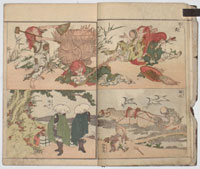
Click here to view image full size.
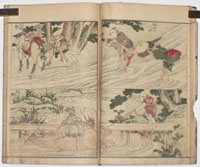
Click here to view image full size.
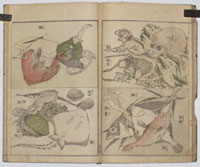
Click here to view image full size.
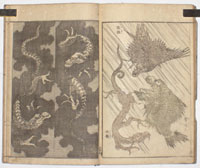
Click here to view image full size.
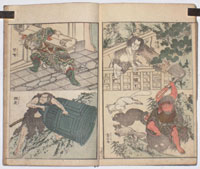
Click here to view image full size.
Katsushika HOKUSAI (1760-1849)
Click here to view image full size.
One volume complete: Denshin kaishu-ippitsu gafu, “Drawing Manual – Album of Drawing with one Stroke of the Brush.” Similar to the ryakuga style which was pioneered by Masayoshi. One of the best known and most influential of Hokusai’s books and one which was reprinted and copied many times. Published 1823 by Eirakuya Toshiro, Nagoya.
Original burnished orange covers. Original title slip. A nice early example: This is a difficult book to find without the fugitive pigments being completely washed out. This example has been in the collection of four collectors: Jaeger; Kari and the other two unread ( seals inside front cover ).
Status: Sold
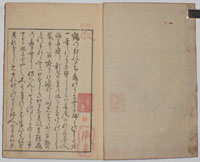
Click here to view image full size.
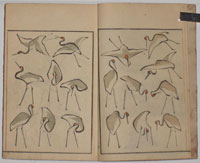
Click here to view image full size.
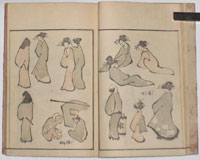
Click here to view image full size.
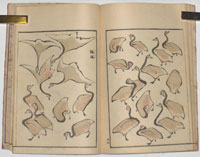
Click here to view image full size.
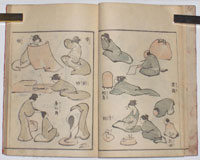
Click here to view image full size.
Katsushika HOKUSAI (1760-1849)
Click here to view image full size.
Three volumes complete: Kyoka yama-mata-yama, “Kyoka: Range Upon Range of Mountains.” The fanciful title is based on the fact that the views illustrated are located around Yama-no-te, the higher ground situated in the north and north-western part of Edo. The pictures accompanied by kyoka poems. This is one of Hokusai’s most admired works. Published 1804 by Tsutaya Jusaburo.
Original dark green embossed covers. Original title slips. A very nice clean copy of this famous book. Some slight smudging of pigments and turning of colour on one or two sheets, but otherwise extremely well retained colour, the elusive blue and purple intact.
Status: Sold
Katsushika HOKUSAI (1760-1849)
Click here to view image full size.
A fine example of the first edition, the “Falcon’s Feather”, of volume one of the Fugaku hyakkei, the “Hundred Views of Mount Fuji.” ( So-called because the title slip is printed in blue with a decorative design of a falcon’s feather – missing on later editions. ) The first volume was published in 3/1834 by the Edo firm of Nishimura Sukezo together with the Nagoya publisher Eirakuya Toshiro and the Edo firms of Kadomaruya Jinsuke and Nishimuraya Yohachi using Hokusai’s favourite engraver, Egawa, amongst others. One of the great and most influential illustrated books. Not just with other Japanese artists, but on European artists of the last century. Full of exquisite compositions, best appreciated in the first or early editions. Due to their popularity, the volumes were reprinted many times. It is also a target for cutting up and separately mounting the pages. Colophon signed: “the old man mad about drawing, formerly Hokusai Iitsu aged 75.”
Original covers and title slip. One small wormhole on a few pages. Otherwise extremely good condition with only minimal soil.
Status: Sold
Katsushika HOKUSAI (1760-1849)
Click here to view image full size.
Volume 1 only of Ehon Sumidagawa ryogan ichiran, “Panoramic Views Along the Bank of the Sumida River”. Published by Senkakudo c1805/6. Minor marks and wormage, otherwise a fine copy, with perfect colour, of the first edition. Original covers and title slip.
Status: Sold
Katsushika HOKUSAI (1760 – 1849)
Click here to view image full size.
Kinutagai, “The Fulling Block Shell” from the series: Genroku Kasen kaiawase, “A Matching Game with the Genroku Poem Shells.” ( An anthology published in 1689. ) A collection of verses with pictures designed by Hokusai printed on 36 sheets. Commissioned by the Yomogawa poetry group for the New Year 1821, Year of the Snake. Shows two women at a fulling block beating down scrap paper to pulp to remake into sheets. In the background a boy is stirring the pulp in a basket in a stream. One of the two best known Hokusai surimono sets. Rare.
Fine impression, very good colour with gold and silver. Minor marks and signs of mounting au verso, otherwise very good condition. Signed Getchirojin I itsu hitsu, “Moonstruck Old Man, Iitsu.”
Status: Sold
Katsushika HOKUSAI (1760 – 1849)
Click here to view image full size.
Sakuragai, “The Cherry Blossom Shell” from the series: Genroku Kasen kaiawase, “A Matching Game with the Genroku Poem Shells.” ( An anthology published in 1689. ) A collection of verses with pictures designed by Hokusai printed on 36 sheets. Commissioned by the Yomogawa poetry group for the New Year 1821, Year of the Snake. Shows travellers on the way to Narita Fudo, the Shinshoji at Naritasan. One of the two best known Hokusai surimono sets. Rare.
Fine impression and colour with gold and silver. Minor marks, otherwise fine condition. Signed Getchirojin I itsu hitsu, “Moonstruck Old Man, Iitsu.”
Status: Sold
Katsushika HOKUSAI (1760 – 1849)
Click here to view image full size.
A rare surimono from a series Soramitsuyaren wakan buyu awase samban no uchi, “Japanese and Chinese Heroes for the Soramitsuya Circle.” ( A club named after its leader Soramitsuya Maeda. ) Shows Benkei in a tug-of-war with a Chinese beauty ( possibly Kosanjo according to Keyes ). Poems by Maeda, Magara and Komichi. Published 1820. Two other impressions illustrated in the Spencer Museum of Art, Surimono, Roger Keyes, Kodansha, 1984, no. 26, p. 74 ( catalogue no 110 ) and the Peter Morse collection catalogue, Ota Memorial Museum of Art, 1988, no. 184.
Fine impression, colour and condition. Extensive gold and silver. Signed Hokusai Taito aratame Katsushika Iitsu hitsu.
Status: Sold
Katsushika HOKUSAI (1760 – 1849)
Click here to view image full size.
A rare surimono from the series Umazukushi, “A Series of Horses” published 1822 ( Year of the Horse ). Shows the banks of the Sumida river, Komatomeishi, with the stone used for tethering horses bottom centre. This surimono is one of three that form a triptych. The complete set is in the Rijksmuseum, Amsterdam ( 1958: 293-294-295 ) and is illustrated in Matthi Forrer, Hokusai, Rizzoli, 1988, no. 265, p. 238 and elsewhere. The other two surimono were also in the Gerhard Schack collection, illustrated in Surimono, 1970, 77-78. Ex collection H. de Winiwater ( seal top right ).
Fine impression with gold and silver. Some soil and loss of the gold. Signed Fusenkyo Iitsu no fude.
Status: Sold
Katsushika HOKUSAI (1760 – 1849)
Click here to view image full size.
A rare long surimono complete with the attached invitation ( yokonagaban ). Mitate junidan soshi, “A Parody from Twelve Fairy Tales.” Shows Ushiwaka and prince Joruri. The invitation is to a dramatic recital with music ( joruri ) organised by Tokiwazu moji kiyo and has the names of the performers: Tokiwazu Komoji dayu; Kishizawa Koshikibu and others from the Kishizawa school. Another example ( lacking invitation ) is illustrated in Masterpieces Of Ukiyoe From The British Museum. Exhibition catalogue of collection of 300 prints from BM exhibited in Japan at Ueno Museum, Tokyo and Nara Prefectural Museum of Art, 1985, no. 194. But otherwise extremely rare as few of these prints can have been produced for this dramatic event. Sometimes the actual designs, without attachments, were reissued at a later date. An early design for Hokusai, c. 1800.
Fine impression with gauffrage. Slight fading and signs, as usual, of the foldmarks on the invitation: These invites were folded three times – once horizontally and twice vertically to form a neat packet. Otherwise very good condition. Signed Gakyojin Hokusai ga.
Status: Sold
Katsushika HOKUSAI (1760 – 1849)
Click here to view image full size.
An exceptionally rare and very unusual koban surimono showing two onnagata actors. The only other recorded impression seems to be in Hokusai, Gian Carlo Calza, Electa, 1999, plate III.57. That has the months on the title slip of book for 1803 (and a poem top left). So this is an egoyomi and my impression must be either a proof or the first issue (same as Harunobu prints issued first without date, then with).
Very fine impression and colour. Signed Gakyojin Hokusai ga.
Status: Sold
Katsushika HOKUSAI (1760-1849)
Click here to view image full size.
Kanagawa Oki Nami-ura from the “Thirty-six Views of Fuji”. The set of forty-six prints published between 1823 and 1829 by Eijudo. Probably the most eulogised Japanese print and the masterpiece from the set as well as being one of the world’s great graphic images.
Medium impression. Blue outline. Very full size. Signed Zen Hokusai I-itsu hitsu.
Status: Sold
Katsushika HOKUSAI (1760-1849)
Click here to view image full size.
Two volumes complete Toto shokei ichiran “A View of the Famous Sights of the Eastern Capital”. Dated Kansei 12 (1800) and published by Tsutaya Jusaburo, Suwaraya Mohei and Suwaraya Ihachi, all of Edo. Original covers, hand-painted with Iris flowers, and title slips. The first edition (probably of 200 copies) was published solely by Tsutaya Jusaburo in 1800 with title Toto meisho ichiran. The example offered here was published shortly afterwards (probably also in 1800). There were also later reprints in 1815 and 1840. One of Hokusai’s best known books and featuring his best work of this period. Difficult to find in an early edition. Ex Kegan Paul Gallery.
Good condition: title slips damaged and some thumbing. A little movement of the blue pigment due to dampness, but overall a nice example of this important work. Signed on colophon Hokusai Tatsumasa.
Status: Sold
Katsushika HOKUSAI (1760-1849)
Click here to view image full size.
A poem by Onakatomi no Yoshinobu Ason from Hyakunin isshu uba ga etoki, the “Hundred Poems explained by the Wet Nurse.” Published by Nishimuraya Eijudo and Iseya Eijudo c 1835/6. Although obviously intended to be a set of 100 prints, only 27 are known plus drawings for the others. The poet speaks of his love being like a fire kept by guards at the Imperial Palace: It only burns hot at night. Shows a group of sleepy imperial guards with the fire burning low. The poet and servant are seen on the distant hill.
Very fine early impression. Fine colour and condition. (The small white area without colour top left should appear on every untrimmed genuine impression.) Signed Zen Hokusai manji (the manji seal black).
Status: Sold
Katsushika HOKUSAI (1760-1849)
Click here to view image full size.
A poem by Kiyowara no Fukayabu from Hyakunin isshu uba ga etoki, the “Hundred Poems explained by the Wet Nurse.” Published by Nishimuraya Eijudo and Iseya Eijudo c 1835/6. Although obviously intended to be a set of 100 prints, only 27 are known plus drawings for the others. The poet speaks of the shortness of the summer night and asks if the moon is still overhead or hidden by clouds. Shows an evening on the Sumida River with a large pleasure boat accompanied by a smaller craft and a vessel providing food.
Fine early impression. Fine colour. Slight centre fold, otherwise good condition. Signed Zen Hokusai manji (the manji seal black).
Status: Sold
